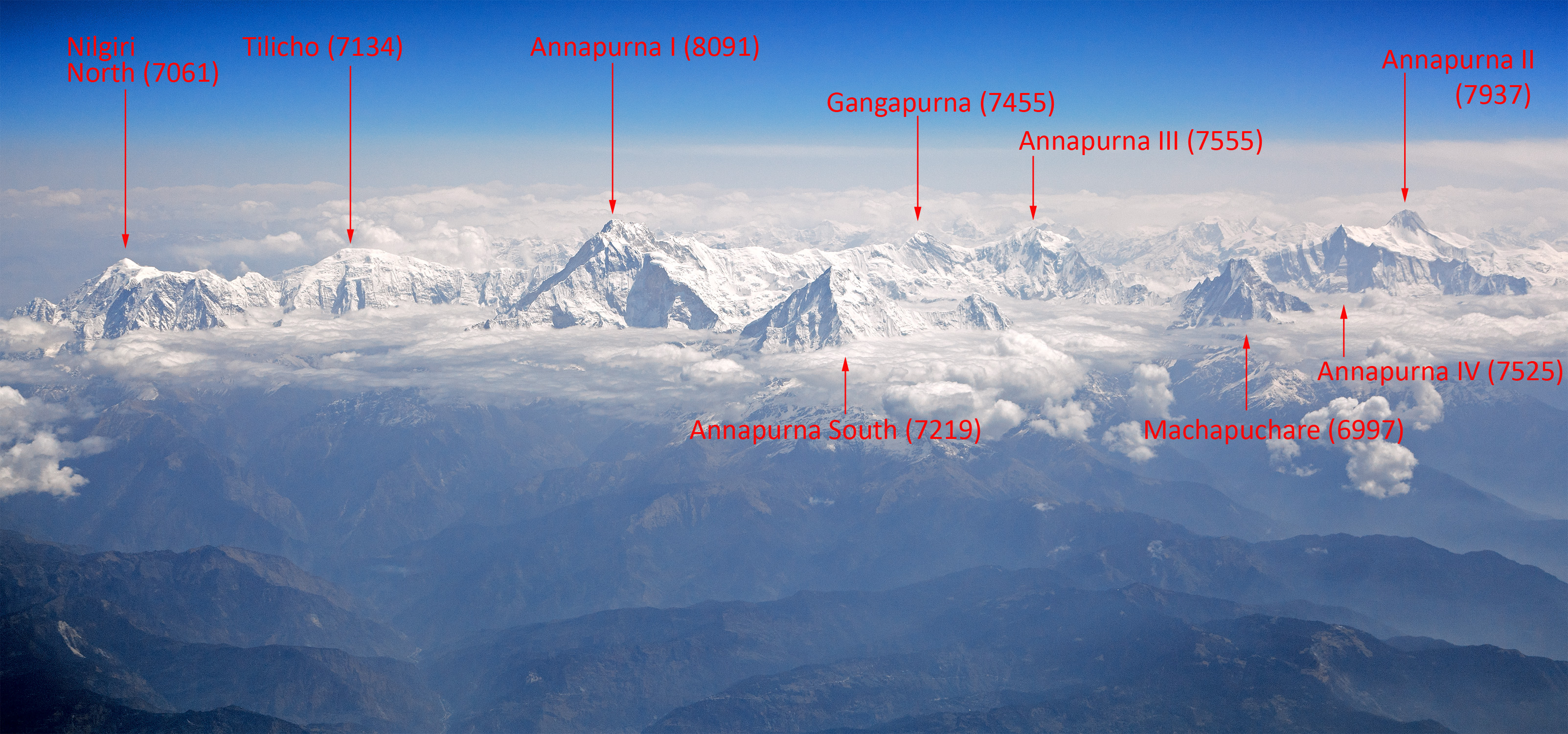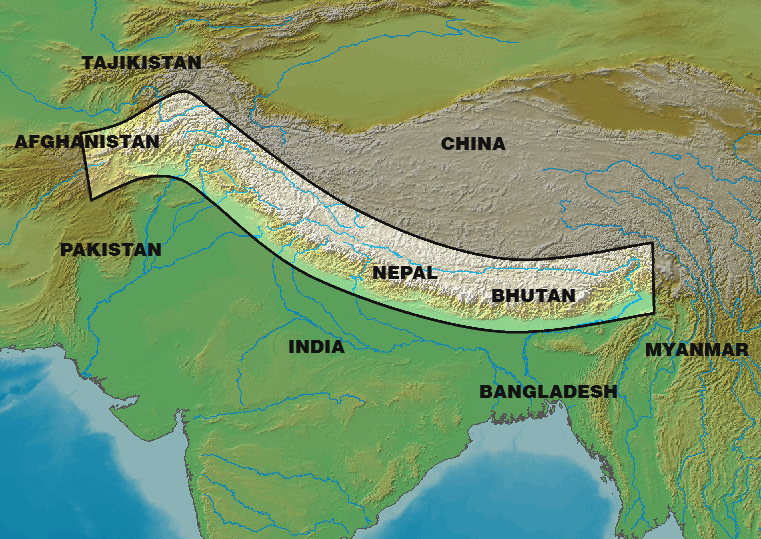|
Mardi Himal
Mardi Himal ( ne, मार्दी हिमाल) is a peak beneath the much more prominent Machapuchare in the Annapurna region of Nepal, from which it is separated by a col. It was first summited in 1961 by Basil Goodfellow. In 2012, the Mardi Himal Trek was opened, following a ridge towards the summit, with lodges and teahouses open to an elevation of 3,550m, with a further climb to "Base Camp" at 4,500m. The peak itself is classified by the Nepalese government as a "trekking peak" and is offered by many expedition companies. References Mountains of the Himalayas Mountains of the Gandaki Province Five-thousanders of the Himalayas {{Nepal-mountain-stub ... [...More Info...] [...Related Items...] OR: [Wikipedia] [Google] [Baidu] |
Annapurna Himal
Annapurna (; ne, अन्नपूर्ण) is a massif in the Himalayas in north-central Nepal that includes one peak over , thirteen peaks over , and sixteen more over . The massif is long, and is bounded by the Kali Gandaki Gorge on the west, the Marshyangdi River on the north and east, and by Pokhara Valley on the south. At the western end, the massif encloses a high basin called the Annapurna Sanctuary. The highest peak of the massif, Annapurna I Main, is the tenth highest mountain in the world at above sea level. Maurice Herzog led a French expedition to its summit through the north face in 1950, making it the first eight-thousand meter peak ever successfully climbed. The name for the range comes from the Hindu deity Annapurna meaning ''the giver of food and nourishment'' due to the evergreen flowing rivers originating from this mountain range which generates greenery and supports vegetation year round on the lower plains. She is also believed to be one of the ... [...More Info...] [...Related Items...] OR: [Wikipedia] [Google] [Baidu] |
Himalayas
The Himalayas, or Himalaya (; ; ), is a mountain range in Asia, separating the plains of the Indian subcontinent from the Tibetan Plateau. The range has some of the planet's highest peaks, including the very highest, Mount Everest. Over 100 peaks exceeding in elevation lie in the Himalayas. By contrast, the highest peak outside Asia ( Aconcagua, in the Andes) is tall. The Himalayas abut or cross five countries: Bhutan, India, Nepal, China, and Pakistan. The sovereignty of the range in the Kashmir region is disputed among India, Pakistan, and China. The Himalayan range is bordered on the northwest by the Karakoram and Hindu Kush ranges, on the north by the Tibetan Plateau, and on the south by the Indo-Gangetic Plain. Some of the world's major rivers, the Indus, the Ganges, and the Tsangpo– Brahmaputra, rise in the vicinity of the Himalayas, and their combined drainage basin is home to some 600 million people; 53 million people live in the Himalayas. The Himalaya ... [...More Info...] [...Related Items...] OR: [Wikipedia] [Google] [Baidu] |
List Of Mountains Of Nepal
Nepal contains most of the Himalayas, the highest mountain range in the world. Eight of the fourteen eight-thousanders are located in the country, either in whole or shared across a border with China or India. Nepal has the highest mountain in the world, Mount Everest as well as 1,310 peaks over 6,000 m height. Mountains Other ranges North of the Greater Himalayas in western Nepal, ~6,100 metre ''Tibetan Border Ranges'' form the Ganges-Brahmaputra divide, which the international border generally follows. South of the Greater Himalayas, Nepal has a ''High Mountain'' region of ~4,000 metre summits, then the ''Middle Hills'' and Mahabharat Range with 1,500 to 3,000 metre summits. South of the Mahabharats, an outer range of foothills with ~1,000 metre summits is called the Siwaliks or ''Churiya Hills''. Gallery of highest peaks File:Everest kalapatthar crop.jpg, Everest File:Kanchenjunga from Tiger Hills.JPG, Kangchenjunga File:Lhotse-fromChukhungRi.jpg, Lhotse File:Mount Mak ... [...More Info...] [...Related Items...] OR: [Wikipedia] [Google] [Baidu] |
Nepal
Nepal (; ne, नेपाल ), formerly the Federal Democratic Republic of Nepal ( ne, सङ्घीय लोकतान्त्रिक गणतन्त्र नेपाल ), is a landlocked country in South Asia. It is mainly situated in the Himalayas, but also includes parts of the Indo-Gangetic Plain, bordering the Tibet Autonomous Region of China to the north, and India in the south, east, and west, while it is narrowly separated from Bangladesh by the Siliguri Corridor, and from Bhutan by the Indian state of Sikkim. Nepal has a diverse geography, including fertile plains, subalpine forested hills, and eight of the world's ten tallest mountains, including Mount Everest, the highest point on Earth. Nepal is a multi-ethnic, multi-lingual, multi-religious and multi-cultural state, with Nepali as the official language. Kathmandu is the nation's capital and the largest city. The name "Nepal" is first recorded in texts from the Vedic period of the ... [...More Info...] [...Related Items...] OR: [Wikipedia] [Google] [Baidu] |
Machapuchare
Machapuchare, Machhapuchchhre or Machhapuchhre (, Tamu: कतासुँ क्लिको), is a mountain situated in the Annapurna massif of Gandaki Province, north-central Nepal. Its highest peak has never been officially climbed due to the impossibility of gaining a permit from the government of Nepal. Location Machapuchare is at the end of a long spur ridge, coming south out of the main backbone of the Annapurna massif, which forms the eastern boundary of the Annapurna Sanctuary. The peak is about north of the provincial headquarter of Pokhara. The sanctuary is a favorite trekking destination, and the site of the base camps for the South Face of Annapurna and for numerous smaller objectives. The Mardi Himal trek, for instance, climbs towards a minor peak. Notable features Due to its southern position in the range and the particularly low terrain that lies south of the Annapurna Himalayas, which contains three of the 10 highest peaks in the world, Machapuchare commands ... [...More Info...] [...Related Items...] OR: [Wikipedia] [Google] [Baidu] |
Annapurna Massif
Annapurna (; ne, अन्नपूर्ण) is a massif in the Himalayas in north-central Nepal that includes one peak over , thirteen peaks over , and sixteen more over . The massif is long, and is bounded by the Kali Gandaki Gorge on the west, the Marshyangdi River on the north and east, and by Pokhara Valley on the south. At the western end, the massif encloses a high basin called the Annapurna Sanctuary. The highest peak of the massif, Annapurna I Main, is the tenth highest mountain in the world at above sea level. Maurice Herzog led a French expedition to its summit through the north face in 1950, making it the first eight-thousand meter peak ever successfully climbed. The name for the range comes from the Hindu deity Annapurna meaning ''the giver of food and nourishment'' due to the evergreen flowing rivers originating from this mountain range which generates greenery and supports vegetation year round on the lower plains. She is also believed to be one of the daught ... [...More Info...] [...Related Items...] OR: [Wikipedia] [Google] [Baidu] |
Mountains Of The Himalayas
A mountain is an elevated portion of the Earth's crust, generally with steep sides that show significant exposed bedrock. Although definitions vary, a mountain may differ from a plateau in having a limited summit area, and is usually higher than a hill, typically rising at least 300 metres (1,000 feet) above the surrounding land. A few mountains are isolated summits, but most occur in mountain ranges. Mountains are formed through tectonic forces, erosion, or volcanism, which act on time scales of up to tens of millions of years. Once mountain building ceases, mountains are slowly leveled through the action of weathering, through slumping and other forms of mass wasting, as well as through erosion by rivers and glaciers. High elevations on mountains produce colder climates than at sea level at similar latitude. These colder climates strongly affect the ecosystems of mountains: different elevations have different plants and animals. Because of the less hospitable ... [...More Info...] [...Related Items...] OR: [Wikipedia] [Google] [Baidu] |
Mountains Of The Gandaki Province
A mountain is an elevated portion of the Earth's crust, generally with steep sides that show significant exposed bedrock. Although definitions vary, a mountain may differ from a plateau in having a limited summit area, and is usually higher than a hill, typically rising at least 300 metres (1,000 feet) above the surrounding land. A few mountains are isolated summits, but most occur in mountain ranges. Mountains are formed through tectonic forces, erosion, or volcanism, which act on time scales of up to tens of millions of years. Once mountain building ceases, mountains are slowly leveled through the action of weathering, through slumping and other forms of mass wasting, as well as through erosion by rivers and glaciers. High elevations on mountains produce colder climates than at sea level at similar latitude. These colder climates strongly affect the ecosystems of mountains: different elevations have different plants and animals. Because of the less hospitable terrain and ... [...More Info...] [...Related Items...] OR: [Wikipedia] [Google] [Baidu] |



